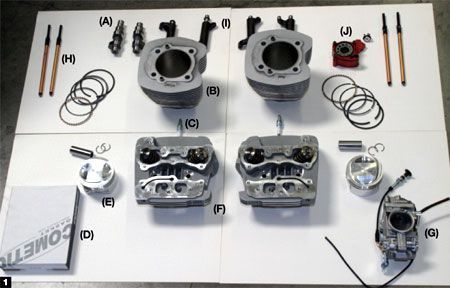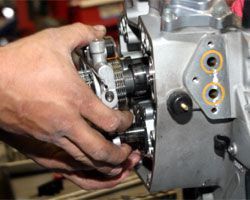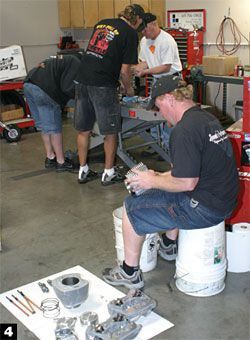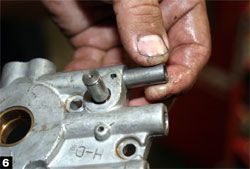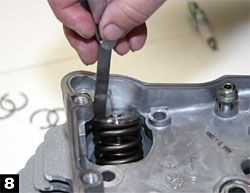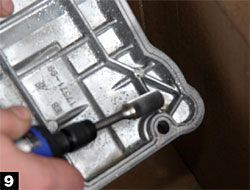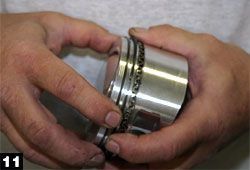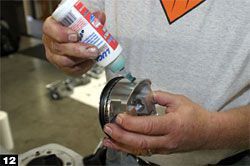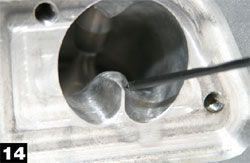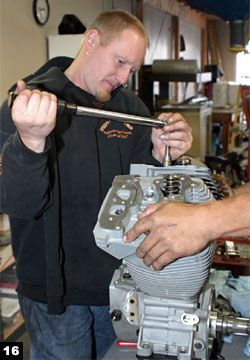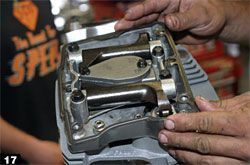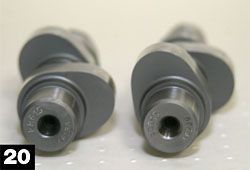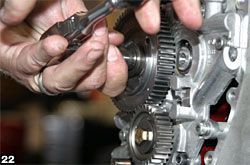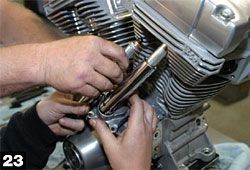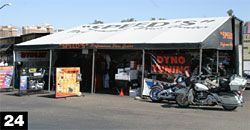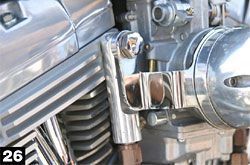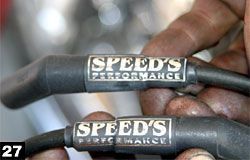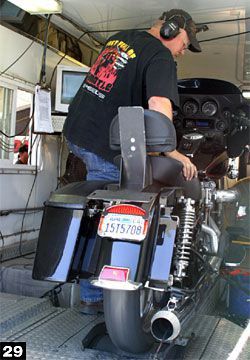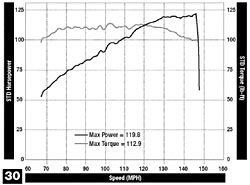THE NEED FOR SPEED
INSTALLING A SPEED’S 95 KIT
By Eric Ellis
Photogaphy by Eric Ellis
Hot Bike Volume 38, No. 9, 2006
OK, imagine this: You ‘ve ridden several hundred or maybe even several thousand miles to hit the grand-daddy of all motorcycle rallies, Sturgis. Your old stock 88 ran great—not a single hiccup the entire trip, although it could have used a little more juice a couple of times when passing those big rigs along the way. Now the rally ‘s almost over, and you ‘re dreading the long road home. What could make the trip home more enjoyable than breathing some new life into your old stocker with a freshly beefed-up 95ci motor producing upwards of 105 lb-ft of torque and 110 hp? That would probably make the ride home a little more exciting, huh? Hell, it might even encourage you to take the long way home!
So now you ‘re probably asking yourself, “How can I find a reputable shop in a town I don ‘t know that can build me a reliable 95-incher, won ‘t rip me off, and will still be around next year when I need a tuneup?” The answer is simple: Speed ‘s Performance Plus (SPP). Not only can Speed ‘s hop up your motor, change your oil, install new pipes, and much more, the company will do it for you at just about every major rally across the nation.
With a mobile workshop better equipped than many shops, SPP is on the road, towing its dyno room/engine-building room/machine shop/retail store/portable work-stations/living quarters throughout the rally season. For the most part you ‘ll find Speed (Wayne, the owner of the company), along with his sons Jamie and Jason and the rest of the crew, set up in the same locations at each rally, banging out motor builds, installing parts, and tuning bikes. Whether you ‘re looking to have a Power Commander installed or want to take the stumble out of your ride, Speed and the boys have you covered.
Now, what about that 95-incher, you say? Well, SPP teamed up with Reggie Ronzello Sr. and Reggie Jr. of R&R Cycles to develop a 95-inch kit for both carbureted and fuel-injected 88ci bikes. It took many hours of research and testing to compile a list of components that work well together, along with developing some of their own proprietary parts to come up with a kit that allowed the team at SPP to achieve 116 lb-ft of torque and 122 hp on one of the company ‘s own bikes.
One of the keys to what makes this such a high-performing kit is the R&R cast cylinder heads. While you could save a couple of bucks by using your old heads as core deposits for a set of reworked Harley heads from R&R, to really get big numbers your best bet is to go with the R&R Vortex-flowed cast heads. Reggie Sr. told us the trick to making horsepower and torque isn ‘t only about stuffing as much air and fuel into the heads as possible; maintaining high velocity is equally important. The team at R&R has spent a lot of time designing, testing, and studying the cross-sectional flow analysis on their heads, so they know the direction and velocity of air at any given point.
Proper headwork is all about design efficiency. All of the R&R cast heads are CNC-ported. Reggie said that every cast head is different, and core shift (a variation of the size and direction of the core) takes place during the casting process. In the casting process the ports are undersized, so R&R can CNC-port every head to get the proper amount of cfm (cubic feet per minute) and velocity for each head. The problem with most heads is that the intake port has a long arc radius at the top but a short bend (almost straight) at the bottom. That short bend at the bottom is such a tight radius that it ‘s difficult for the incoming air to bend around it, so the air ends up separating and ricocheting around, losing its velocity and ability to flow the entire valve. To solve this problem, most people will run larger valves to catch more air around the part of the valve that ‘s flowing, but that still doesn ‘t solve the problem of that short bend.
R&R ‘s solution to the problem is the Vortex Generator, which has been around since the ‘90s. The Vortex Generator is a raised section of the port floor that splits the air and bends it around the short bend. The Vortex Generator is able to do this because its design creates a longer short-turn radius, making it easier for the air to flow around the bend, thus increasing velocity and flowing the entire valve. Because this head design is so efficient and flows the entire valve, not just part of it, R&R can run smaller ports and valves (1.94-inch intake and 1.625-inch exhaust valves) and still get the same cfm as those running larger ports and valves.
We had heard the SPP crew was going to be hanging out in the Phoenix area, taking care of a few errands before the Laughlin River Run. So we asked if they ‘d be interested in making a quick trip out to Southern California to install one of their 95 kits on one of our baggers. Then we ‘d put some break-in miles on the bike on the ride out to Laughlin and head over to the SPP setup in Bullhead City to have the bike tuned and dyno ‘d. The guys at SPP were more than happy to do the job. The base SSP Stage III 95 kit includes reworked H-D TC heads, cams with gear-drive setup, adjustable pushrods, ignition or Power Commander, bearings and gaskets, barrels, pistons, and rings and retails for about $3,214.
Here are some of the components that make up the SPP 95-inch kit: (R&R/Speeds) RS 615 cams (A), R&R bored cylinders (B), Iridium spark plugs (C), Cometic gasket kit (D), RR/JE 3.785-bore aluminun forged pistons (E), R&R Cycles Vortex-flowed cast heads (F), and a Mikuni 48mm carb (G). Some components not shown are SPP Kevlar cord spark-plug wires, SPP crank vents and air-cleaner setup, and an S&S gear-drive kit to go with the RS cams. Since we were tearing into the motor anyway, we decided to upgrade with Andrews adjustable pushrods (H), Crane roller rockers (I), and a Fueling oil pump (J).
When the SPP team arrived at the shop, we already had the motor out of the frame and pretty much torn down. Speed and the boys attacked the motor just as they would if they were in their rig; each guy had a specific job to do. Speed started by pulling the cams.
Speed suggests that when performing a high-performance motor hop-up you should always check the runout on the pinion shaft. He said the runout shouldn ‘t be more than 0.003 inch; any more than that, and you experience power loss. The runout on our bike was 0.002 inch, so we were OK.
Speed mentioned that on many baggers you ‘ll notice there ‘s zero oil pressure at idle. He said that most likely it ‘s because the oil plunger in the cam plate is stuck and not properly seated. SPP ‘s crew has a little trick they use to make sure the plunger gets properly seated. With their modification, Speed said they increase the oil pressure up to 15 psi at idle.
While the oil plunger was being taken care of, rings were set in the cylinders and checked for proper end gap.
R&R uses its own valvespring setup on its heads. So Jamie checked for clearance on the inside of the rocker boxes to make sure there was enough room for the springs. There was plenty of room, so the rocker boxes didn ‘t need to be clearanced.
However, since we were installing roller rockers, the rockerbox covers had to be marked and clearanced for the rocker arms.
A small portion inside the cam cover had to
be clearanced as well to accommodate the camshaft drive gears.
Before they came out to our shop, the guys from SPP met with Lucas Oil and set up a deal to use its products, so it only made sense to use some Lucas Oil assembly lube on the pistons. Since the cylinders still had a thin film of ATF on them to act as a lubricant, Speed only lubed up the piston skirt.
Here it is, a close-up look at the beautiful porting work R&R Cycles does. The raised section of the port is what Reggie calls his Vortex Generator. The key to a high- performance port job is design efficiency. The Vortex Generator is designed to cure the problem of fuel standing in the intake tract at low rpm and maintain velocity by splitting and bending air around the port floor radius. R&R has designed these heads to run smaller intermediate and main jets, using more of the lower rpm where most people really want it. With higher velocity the atomized fuel stays in suspension, so when you first hit the throttle it ‘ll be an instantaneous snap.
At the other end of the head, R&R runs a D-shaped exhaust port sized properly for the amount of air going out, so it won ‘t flow too much or too little. The crew also created a small bump on the bottom floor of the exhaust port to increase exhaust velocity and control the air out of the port. The combustion chamber features a modified bathtub design. R&R designed the combustion chamber to induce a swirl effect on the air coming in so it wouldn ‘t storm across and slam into the cylinder wall; instead, the air will spiral down directly toward the center of the cylinder. R&R designed it so the air will cross over the top of the exhaust valve to preheat it for the combustion stroke to get a more complete burn.
Once the heads were torqued, the top end was buttoned up with the rocker boxes and rocker-arm assemblies.
Back down at the lower end, the Fueling oil pump was installed. The Fueling pump increases pressure volume by 40 percent and scavenge volume (return) by 60 percent more than stock.
These are the RS 615 cams. The cams were designed by R&R and Speed ‘s. The cams are manufac tured by Andrews and feature a .615-inch lift with 250 duration on the intakes and .585-inch with 260 duration on the exhausts. The cams were designed so they won ‘t over or under-lift the valves, while still maintaining velocity.
Next, the S&S drive gears were installed. Speed checked to see that they were aligned and meshed properly. If the gears mesh too tightly, they will cause the motor to whine, and if they mesh too loosely they will clatter. Everything checked out, so the gears were torqued to S&S ‘ specs.
Once the cams were pressed into the cam plate, the plate was bolted to the cam chest, and Speed checked to make sure the cams would turn freely. It ‘s a good thing he checked, because the cams were just barely hitting the case. Speed said that not all cases are exactly the same, and ours just happened to have a little extra material around the pinion shaft support, which is what the cams were hitting. So it was clearanced just a tad.
With the motor-build portion pretty much wrapped up, the lifters, pushrods, and AB Tech pushrod-tube covers were installed. The motor was then bolted back in the frame. In order to run the 48mm Mikuni carb with the R&R heads, we had to pick up a hrowback G manifold from T-Man Performance. Then the motor was prepped for the 300-mile break-in ride to Laughlin, where we would finish off the project.
During the Laughlin River Run, SPP set up on the other side of the river in Bullhead City. So first thing Friday morning we rode over to the company ‘s rig, which already had customers wanting this and that installed on their bikes.
Then it was over to the dyno room, where Speed does his best work. Needless to say, Speed has spent more hours in a dyno room than many people have spent on their bikes. With all that experience comes specific knowledge on how to get the results he wants, whether it ‘s knowing if he needs to increase or decrease the jets on a carb or give the ignition a little tickle.
After about 30 minutes, Speed had the bike dialed in close to where he wanted it and making some damn good numbers. Speed had our new 95-incher putting out 119.8 hp and 112.9 lb-ft of torque. Those are awesome numbers, especially when you consider that SPP advertises this kit as putting out between 107-112 hp and 105-112 lb-ft of torque. Even though he was pretty happy with the numbers our bike put out, Speed felt there were a few factors, such as the two-into-one pipe (not the SPP-recommended D&D pipe), more than 100-degree temperature in the dyno room, and fairly low break-in miles that were holding our bike back from producing the 122 hp and 116 lb-ft of torque that the SPP bike was making. He said with so few miles on the motor it was still pretty tight, and with about 2,000 more miles the motor will loosen up and produce a little more torque and horsepower.
Article reprinted with permission from HotBike Magazine.

